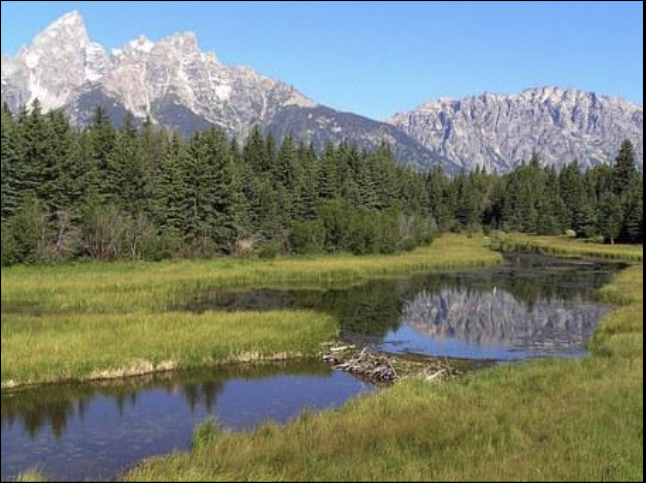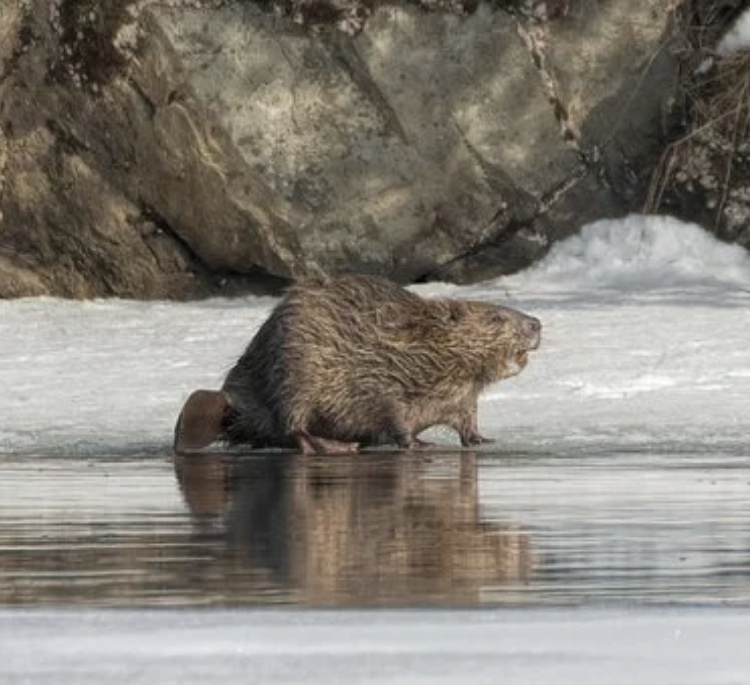By Pam Sherman
Why bother with beavers?
If you are living in a dry, hot climate like the Front Range plains, you may wish for any way to increase the water available to your gardening and landscaping efforts. Supporting the beavers living in your area is one important way to do this. Beavers lived here long before humans did. Beavers do naturally what we native habitat gardeners and landscapers are working so hard at: restoring the native ecosystem. No animal or human can beat a beaver at this. The more we learn from beavers how to do this and the more we support resident beavers when they find homes in urban and suburban areas, the closer to Wild Ones’ goals of habitat restoration we will all be.
In addition, it behooves us as stewards of the land, to broaden our horizons and think beyond the little patch of land we are trying to nourish, and understand the larger landscape.
Imagine the broad mountain valley or gentle forest stream closest to you, awash in biodiversity, teeming with pollinators, native insects, birds, fish, and plants you never knew existed, bordered by fast-growing willows, alders, cottonwood, aspen and other riverine plants. Here, rivers and streams do not rush furiously in a single gully-like channel to the sea; rather, they meander on their floodplains, saturating soils, bringing this paradise to life from mountain headwaters down to their valleys.

Photo courtesy of 12019 at Pixabay
Beaver used to live in almost every year-round stream in America. (Those within the beaver community often use ‘beaver” as plural instead of the colloquial “beavers”). In some locales, they were able to live for hundreds if not thousands of years. In others, they moved on when their favorite food became scarce. Abandoned ponds and complexes filled in, becoming fertile soil which would later delight settlers, who had beaver to thank for much rich farmland. Most settlers did not realize beaver were their benefactor.
Beaver fur was so valuable for hats back in Europe, which had harvested its own beavers to extinction by the 1600s, that it literally became the coin of the realm; see Frances Backhouse’s Once They Were Hats for more on this. Trapping in the 1800s all over the West all but eliminated the beaver here, as it did in the rest of the U.S. and Canada. Sixty to 400 million beaver reputedly lived and worked in what is now the U.S. before trapping. Beaver DNA was found in sediment from 7,250 years ago.
They have rebounded to an estimated 10-15 million in the US right now, mostly in wetter areas. There are some ideal beaver-inhabited locales in Colorado, but few and far between. What keeps beaver from reaching their previous numbers and re-hydrating our parched landscapes? Roads, development, development, development, habitat fragmentation, water diversions, pollution, the view of beaver as a nuisance animal, old trapper laws, and fear that beaver are stealing water from humans rather than recharging groundwater, raising the water table, and helping humans access more water than we are used to in this dry climate.

Photo courtesy of Janeenga at Pixabay
Beaver Restoration and Climate Change
Completed and ongoing scientific studies and successful recent restoration projects all over North America are providing context to deal with these fears. See the book Eager: The Surprising, Secret Life of Beavers and Why They Matter by Ben Goldfarb, a well-researched page-turner on this topic, the gateway book for many to the world of beaver restoration for endangered amphibians, salmon and other fish, insects, plants, landscapes by helping to keep the water where it falls.
Now with wildfires raging, experts are recognizing that beaver meadow complexes create refuges for all kinds of species during intense wildfires. They can do so anywhere they are allowed to live, urban or rural.
Modern beaver living near humans do unwittingly eat favorite trees or flood roads. However, modern humans are equal to the task of outsmarting them so both can co-exist peacefully. For an intro, See Coloradan Nichole Fox’s intro here. Then see Skip Lyle’s Beaver Deceiver website or Mike Callahan’s Beaver Solutions site. Or this short video on Denverite Sherrie Tippie, veteran beaver relocator in Colorado.
Support Beaver in Colorado!
The Colorado Beaver Working Group “is a collaborative space for making connections between practitioners, landowners, groups, agencies, and individuals working to promote beaver as a natural way to restore streams and wetlands for the benefit of people, plants, and wildlife.” It’s the hub for what’s happening beaver-wise in Colorado and nearby.
This group is now blossoming prolifically. Natural resource professionals such as Ashley Hom, a USFS Gunnison National Forest hydrologist, are implementing programs to bring back the beaver. Watch her presentation at the first Colorado Beaver Summit here. Click here for the whole fabulous range of Colorado Beaver Summit presentation recordings. Nicole Fox in Durango founded and runs Give a Dam, an organization dedicated to beaver restoration and education, whose motto is “in beavers we trust.”
Don’t miss this article on ranchers, farmers, climate change, water harvesting and beavers. Everyone working on beaver restoration as a nature-based solution is busy as the proverbial beaver.
Pam Sherman is a beaver believer.

Colorado Beaver Working Group–basic info and the place to join the CBWG working group
Montana Beaver Working Group–excellent info
Worth a Dam, Martinez CA Beavers – Heidi Perryman’s site bursting with info
Give a Dam, Durango great photos, great education and restoration organization
Tulalip Tribes Beaver Program–in WA, inspiring
Beaver Restoration Assessment Tool–BRAT The tool for this purpose
Beaver Ecology and Relocation Center University of Utah– a center of action to “give beaver a dam!”
Bring Back the Beaver Campaign in California–central website of those who have been working on this for two decades, with success
